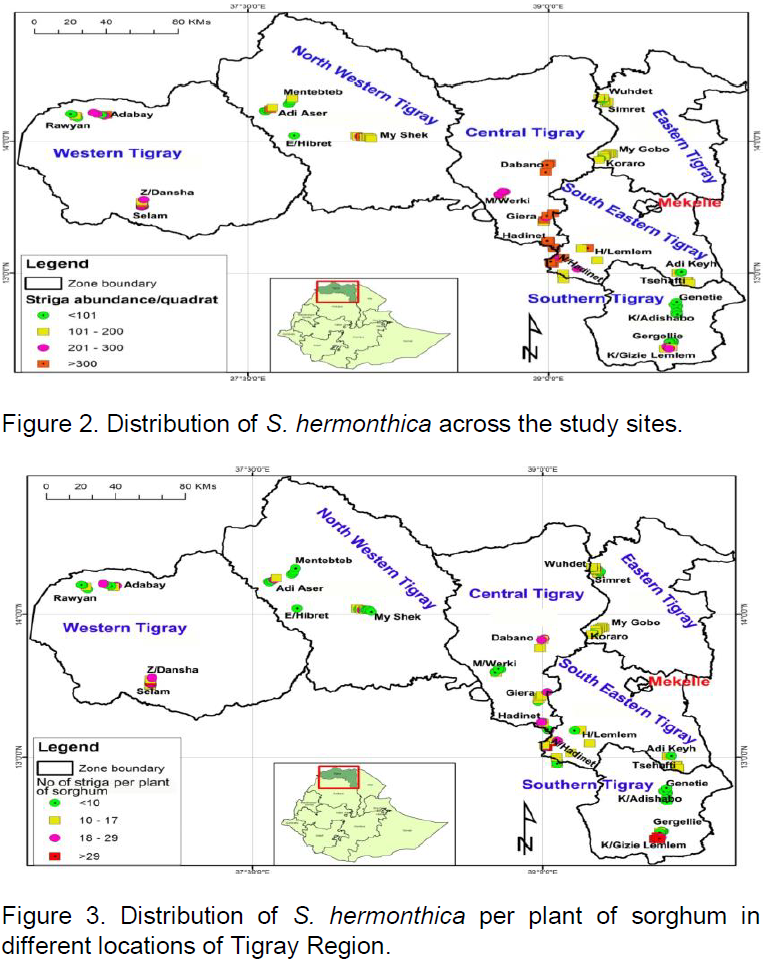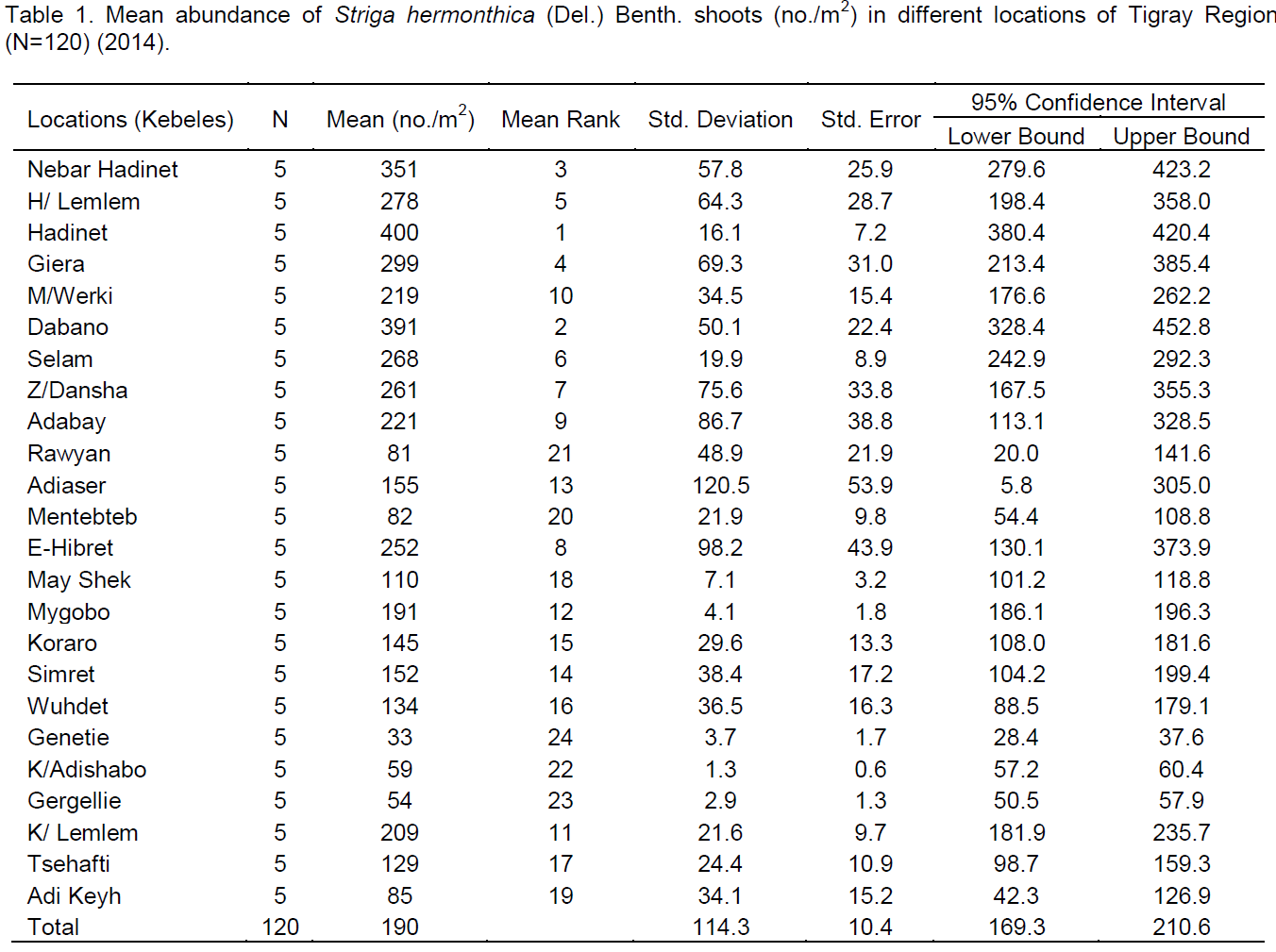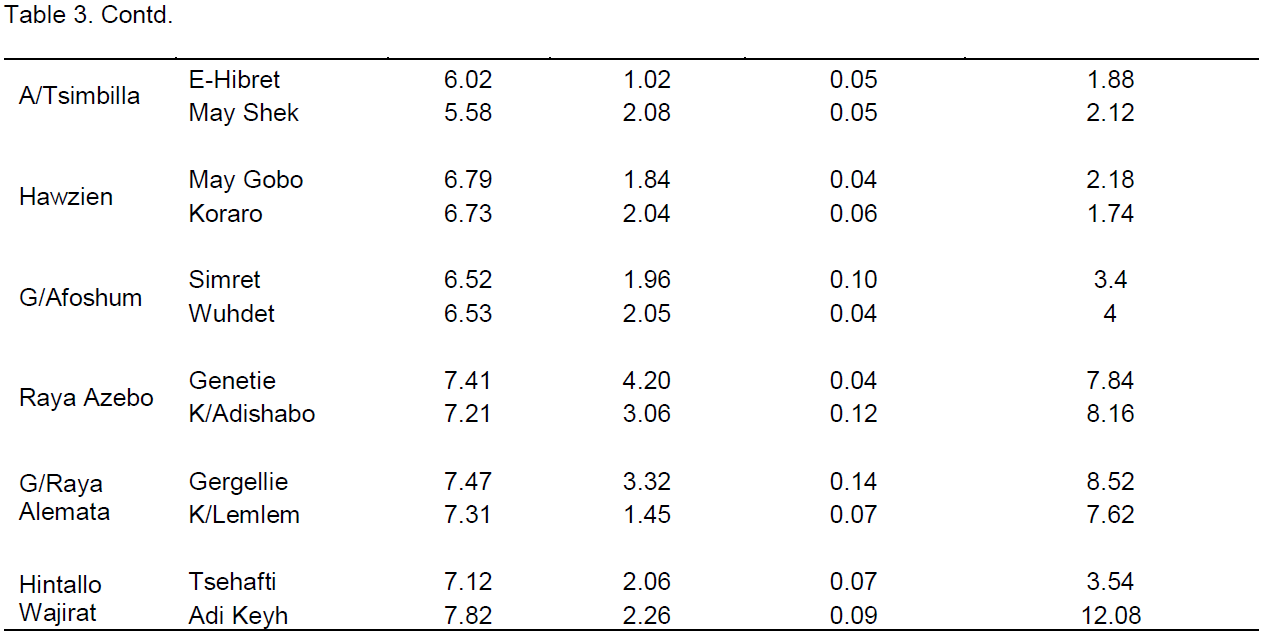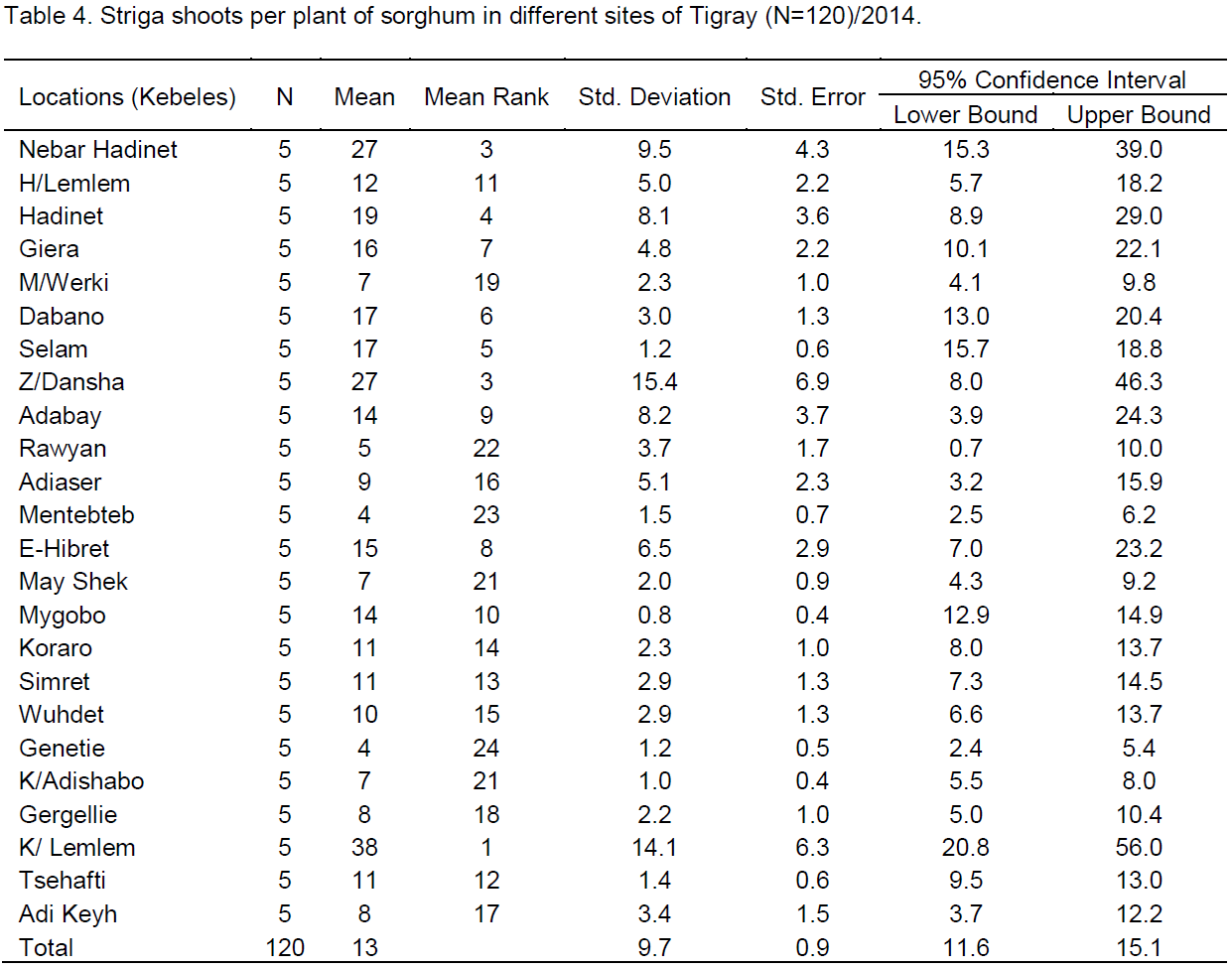ABSTRACT
A survey was conducted in 2014 to determine the abundance and distribution of Striga hermonthica in selected woredas of Tigray. S. hermonthica was commonly distributed across all study sites, its prevalence varied among sites (Kebelies). The highest levels of Striga infestation was observed at Hadinet (400), Dabano (390), Nebar Hadinet (351), Giera (299), Hadas Lemlem (278), Selam (267), and Zuriya Dansha (261). Whereas, the lowest levels of Striga infestation was registered at Genetie (33), Gergellie (54), Kara Adishabo (59), Rawyan (81), Mentebteb (81), and Adi Keyh (84) shoots of striga shoots per m2, respectively. Abundance and distribution map of S. hermonthica was developed for the study area. On the other hand, the highest density of Striga shoots per plant of sorghum was recorded at Kulugizie Lemlem (38), Nebar Hadinet (27), Zuriya Dansha (27), Hadinet (19), Selam (17), Dabano (17), and Giera (16) respectively. Whereas, the lowest density of Striga shoots per plant of sorghum was registered at Genetie (4), Mentebteb (4), Rawyan (5), May Shek (7), Kara Adishabo (7) and Mitsa Werki (7). The highest level of Striga infestation was recorded at sites which had got the highest population density of sorghum, sites with low organic matter and available soil phosphorous content and sandy textured soils. Management practices channeled towards improving these limitations have been suggested for controlling of S. hermonthica in the region.
Key words: Abundance and distribution, Striga, sorghum, Tigray region.
The agricultural sector is the largest contributor to the economies and livelihoods of many African countries and on it accounts for 35% of the continent’s GDP, 40% of export earnings and 70% of employment (Nyage et al., 2011). Although its share of GDP has been declining steadily over the past decade, agriculture continues to be the backbone of the Ethiopian economy, contributing 42.7% to GDP, about 80% of employment and 70% of export earnings (UNDP, 2014).
Crops are the major source of food for humans and constitute 93% of the world’s diet (Stubbs et al., 1986). Of the crops, cereals contribute two thirds of the food, of which wheat, maize and rice together account for 87% of all grain production world wide and 43% of all food calories (FAO, 2007). In Ethiopia cereals occupy about 79% of the area and account for 86% of the production from the major crops (CSA, 2014).
Sorghum [Sorghum bicolor L. Moench] is one of the world’s major cereal crops. It is the fifth most important crop globally and feeds around 500 million people (Shapiro and Wortmann, 2006). It is most widely grown in the semi arid tropics frequently subjected to drought and where water availability is limited. About 100 countries grow sorghum. Of these, 66 cultivate over 1000 ha. Asian and African countries like India and Nigeria have the largest area devoted to sorghum cultivation. Those in West Asia (like Israel and Jordan) and Europe (Italy and France) reaped the highest yields (FAO, 2007).
Ethiopia is the fifth major producer and consumer of sorghum in Africa and eighth in the world. In Ethiopia, sorghum is the major crop next to teff grown all over the country across high, intermediate and low altitude areas and it is the second in total productivity next to maize. Sorghum occupies 0.7 to 1.1 million hectares with 1 to 1.6 million tons of production annually. It contributes about 15-20% of total cereals production in the country. Sorghum production in Ethiopia is showing an increasing trend in the past 15 years (Sinafikeh, 2008).
Sorghum is the dominant crop in Tigray (Northern Ethiopia) where it accounts for 14.5% of the total cultivated area. In the region the average annual coverage of sorghum is 255,000 ha (Shapiro and Wortmann, 2006). Though the productivity of sorghum has increased in the last few years, the overall national productivity of sorghum is low (2.106 t/ha) compared to the average production of 2.3 t/ha of developed countries (CSA, 2013). The low productivity of sorghum can partially be attributed to the parasitic weed Striga hermonthica. (Gebreyesus et al., 2011).
Striga is a Latin word which stands for ‘witch’. It is known as witch weed because it causes stunted growth and early discoloration of crop leaves before its emergence (Fischer, 2006). There are many Striga species which are economically important. Of the most economically important Striga species worldwide are purple witch weed (S. hermonthica (Del.) Benth.) and Asiatic witch weed (Striga asiatica (L) Kuntze). Among these S. hermonthica is the most damaging parasitic weed in the study area. Therefore S. hermonthica has been studied in this survey and will henceforth be referred to as Striga.
S. hermonthica is a plant which grows up to 80 cm with hairy, hard quadrangle shaped and fibrous stem, narrow leaf, and spike-shaped raceme inflorescence bearing up to 60 flowers for the terminal and 10 ~ 20 for the latera linflorescence with bright pink, rose-red, white, or yellow color (Musselman, 1980). The weed is dependent on its host during parts of its life cycle, that is, germination, flowering and reproduction. The root system of Striga is vestigial, where the germinated seed radicle produces haustorium instead of characteristic angiosperm root in order to interact with the host. The seeds are very tiny and range between 0.15 ~ 0.3 mm in diameter (Andrews, 1947). However, many biological aspects of striga including photosynthesis, respiration, transpiration, water relations, cause of heavy crop yield reductions, morphology, and analoging of the haustorium in relation to its function are not fully understood (Haussmann et al., 2000).
S. hermonthica has a wide host range, however it is the most ubiquitous parasitic weeds of staple crops namely maize, sorghum, pearl millet (Pennisetum glaucum), upland rice, tobacco, and sugarcane (Musselman, 1980; Gebisa Ejeta, 2007). Its seed germinate only after being exposed to favorable moisture and temperature conditions for several days (preconditioning). If the condition does not favor germination of seeds remain dormant for several months (Cardoso et al., 2010). Striga seed can remain viable for up to 20 years (Berner et al., 1996).
S. hermonthica is believed to be originated around the border of Sudan and Ethiopia (currently referred to as Nuba) where it causes severe losses in most cultivated crops, impacting the livelihoods of over 100 million African people. Though, it is endemic in the African savanna currently, Striga constrained the production of sorghum globally (Parker and Riches, 1993).
The annual yield loss and geographic distribution of striga infestation is steadily increasing, particularly, in Sub-Saharan Africa. Most of the available research findings show that the average yield loss of sorghum due to striga exceeds 50% and in severe cases complete crop failure can occur, forcing farmers to abandon cereal production (Abunyewa and Padi, 2003).The situation in many locations is getting worse because continuous cultivation of susceptible crops and the limited application of agricultural inputs (Mando, 1997).
Based on the reports of Hadas (2010), S. hermonthica mainly disseminated across farms through floods from nearby farms, farm tools, and/or via winds. Similarly the statement of Berner and his colleagues (1996) revealed that the seeds of striga are mostly introduced by contaminated host crop seeds and by cattle.
S. hermonthica is a major biotic constraint in sorghum growing parts of Ethiopia in general and in the Tigray region in particular. However, the current prevalence and distribution of Striga is not accurately known and clearly indicated on map. Therefore this study has been designed to determine the prevalence and distribution of S. hermonthica infestation across locations of Tigray region.
The study was conducted in 2014 in the regional state of Tigray, northern Ethiopia (Figure 1). It covers a total area of 53,000 square kilometers. Geographically, it lies between 12º15’N and 14º57’N latitudes and 36º27’E and 39º59’E longitudes. There are three regionally recognized seasons in Tigray. The first is the main rainy monsoon season which lasts from June to September (locally called Kiremti), the second is the dry season from October to February (called Kewee), and the third is pre-monsoon hot season from March to May (called Hagay) (Fasil Reda, 2010).
An informal survey was made before the commencement of the actual research survey activities (ILCA, 1990). Following the informal survey a total of 12 major sorghum growing districts were selected from the whole of Tigray in consultation with Tigray Bureau of Agriculture and Rural Development experts. Two districts (woredas) and sites (Kebeles) were selected purposively from each zone and districts respectively. Thus, a total of five sorghum growing fields per site were selected with a systematic random sampling method. Field surveys were conducted from mid September to the end of October 2014 when S. hermonthica was easily visible above ground. The history of the field such as the field management practices, preceding crops, and the type of cultivar that farmers grow was noted during the research survey. Taking this into consideration the survey was conducted at fields sown with local cultivars of sorghum for at least three years.
Sampling was made following community made pathways and road transect survey method (Wittenberg et al., 2004) was employed for sampling of striga and sorghum between farms within site. Two inverted ‘M’ patterned 50 m long transects, on average 1 km apart from each other was determined by systematic random sampling method. Finally, 10 evenly spaced sampling points per m2 were established. Hence, a total of 1200 sampling points (one m2 each) were delineated from 120 sampling sites and finally S. hermonthica and sorghum counts were made. Data collected from a total of ten sampling points (one m2 each) per field were summarized and finally the abundance of S. hermonthica and the plant density of sorghum were determined (Booth et al., 2003).
The number of striga shoots per sorghum plant was determined once striga abundance and the population of sorghum m-2 were determined. To arrive at the latter figure, the density of striga and the population of sorghum in the whole sampling area had to be computed. Finally, the number of striga shoots per sorghum plant was determined by dividing average number of striga by the density of sorghum per m2 (Booth et al., 2003).
During the biophysical survey about 120 waypoints were identified and the coordinates of each waypoint was recorded using hand held GPS. The data on level of infestation, number of sorghum plants and number of striga shoots per sorghum plant at a sampling point was recorded on a spread sheet along with the coordinates of each study site. Finally an accurate map showing the distribution of S. hermonthica and number of striga shoots per sorghum plant was developed.
Abundance and distribution of S. hermonthica
Based on the results of the research survey, striga was distributed throughout the study areas (120 sites) (Figure 2). However, the levels of striga infestation differ among sites.
Accordingly the highest number of striga was recorded in most sites relatively. On the other hand, there are a few sites which have got less infestation level of striga per m2. Striga are mostly introduced and disseminated by contaminated crop seeds, floods, farm tools, cattle and via wind (Berner et al., 1996; Hadas, 2010). These could be the reason for the occurrence and distribution of Striga at different level across locations.
The analysis of variance result (Table 1) revealed that the average level of striga infestation was 190 striga shoots per m2. The highest striga infestation was observed at Hadinet (400), Dabano (391), Nebar Hadinet (351), and Giera (299) striga per m2 respectively. In contrast, the lowest striga infestation was observed at Genetie (33), Gergellie (54), and Kara Adishabo (59) striga per m2 respectively.
The highest sorghum plant population was recorded almost in all kebeles with the exception of Nebar Hadinet (14 plant stand m-2) (Table 2). The plant population recorded at Hadinet (26), Dabano (24), Giera (19), Hadas Lemlem (25) and Selam (15) was by far greater than the population at Genetie (9), Gergellie (7) and Kara Adishabo (9) sorghum per m2 respectively. In most cases, the recorded figure was by far greater than the nationally recommended optimum population density of sorghum per unit area of land (8-9 sorghum m-2) (EIAR, 2007).
Consequently the highest level of striga infestation was also recorded in the sites with the higher plant population. There are many reasons for the high numbers of striga shoots registered; most probably due to the extensive root systems produced by higher density of sorghum. Esilaba et al. (2000) reported that the emergence of striga is positively associated with increased root surface area due to extensive roots systems of sorghum and the subsequent release of germination stimulants.
The results of soil laboratory analysis revealed that the lowest amount of organic matter content was recorded at almost all study sites with exception of Genetie, Gergellie and Kara Adishabo compared than the minimum required amount (2-4%).
The soil laboratory analysis result (Table 3) showed that the amount of organic matter content at Hadinet, Dabano, Nebar Hadinet, Giera, Hadas Lemlem, Selam, and Zuriya Dansha was 0.58, 0.79, 0.89, 0.90, 0.90%, 0.99 and 1.01%, respectively. Whereas, the amount of soil organic matter recorded at Genetie, Gergellie, and Kara Adishabo was 4.2, 3.32 and 3.06% respectively. Therefore the highest level of striga infestation across most study sites occurred in soils low in organic matter and available phosphorous. This result is in lined with the findings of Samaké et al. (2005) who stated that striga infestation is strongly associated with decline of soil fertility, thus the problem is aggravated as a result of the decline of soil fertility.
Prevalence of S. hermonthica around individual sorghum plant
As the average level of striga infestation per m2 varied, the numbers and distributions of striga around the individual stands of sorghum were different across sites (Figure 3). The result of the survey indicated that the highest density of striga per plant of sorghum was recorded at the study sites of Kulugizie Lemlem (38), Nebar Hadinet (27), Zuriya Dansha (27), Hadinet (19), Selam (17), Dabano (17), Giera (16), and Edaga Hibret (15) respectively (Table 4). Whereas, the lowest density of striga emerged around plants of sorghum was registered at Adi Keyh (8), Gergellie (8), Mitsa Werki (7), May Shek (7), Kara Adishabo (7), Rawyan (5), Mentebteb (4), and Genetie (4). This could be due to the fact that density of striga per plants of sorghum depends on the type of cultivars of sorghum, the variability of locations and mean population of sorghum. The germination and survival of striga has been associated with the host and the factors that affect the host. It is expected that, cultivars used by farmers have their own unique level of susceptibility to striga.






S. hermonthica was distributed over all the surveyed areas with altitudes ranging from 621-2245 m above sea level. However, its abundance was not even across the sites. The highest striga infestation was observed at Hadinet, Dabano, Nebar Hadinet, Giera, Hadas Lemlem, Selam Zuriya Dansha and Edaga Hibret. Conversely the lowest density of striga infestation was recorded at Genetie, Gergellie, Kara Adishabo, Rawyan, and Mentebteb followed by Adi Keyh, May Shek and Tsehafti.
Striga shoot count per sorghum plant was found to be different across locations. Accordingly the highest relative count of striga shoot per sorghum plant was registered at Kulugizie Lemlem, Nebar Hadinet and Zuriya Dansha. Conversely, the lowest density of striga was recorded from Kara Adishabo, Rawyan, Mentebteb and Genetie.
Finally, the highest level of striga was recorded at sites which had got the highest population density of sorghum, less organic matter content and available soil phosphorous content. Therefore management practices should be channeled towards using proper planting of sorghum, improving organic matter content of the soil, available phosphorous and soil pH so that to control S. hermonthica in the region. The abundance and distribution was limited in scope and geographic coverage. Therefore, detailed and broader studies should be carried out in the future covering areas away from the road sides. This will allow for specific conclusion on abundance and distribution of S. hermonthica.
The authors have not declared any conflict of interest.
REFERENCES
|
Abunyewa AA, Padi FK (2003). Changes in soil fertility and Striga hermonthica prevalence associated with legume and cereal cultivation in the Sudan savannah z one of Ghana. Land Degradation Dev. 14: 335-343.
Crossref
|
|
|
|
Andrews RW (1947). The parasitism of Striga hermonthica Benth on leguminous plants. Ann. Appl. Biol. 34:267-275.
Crossref
|
|
|
|
|
Berner DK, Carsky R, Dashiell K, Kling JG, Manyong VM (1996). A land management based approach to integrated Striga hermonthica control in Sub-Saharan Africa. Outlook Agric. 25:157-164.
|
|
|
|
|
Booth BD, Stephen D, Swanton CJ (2003). Studying Community Structure and Dynamics. Weed Ecology in natural and Agricultural systems pp 255-274.
Crossref
|
|
|
|
|
Cardoso C, Ruyter-Spira C, Bouwmeester HJ (2010). Strigolactones and root infestation by plant- parasitic Striga, Orobanche and Phelipanche spp. Plant Sci. 180:414-420.
Crossref
|
|
|
|
|
Central Statistics of Agency (CSA) of Ethiopia (2013). Agricultural Sample Survey Report on Area and Production of Major Crops
|
|
|
|
|
Central Statistical Agency (CSA) (2014). Report on area and crop production forecast for Major Grain Crops. Addis Ababa, Ethiopia.
|
|
|
|
|
Esilaba AO, Fasil R, Ransom JK, Wondimu B, Gebremehdin W, Beyenesh Z (2000). Integrated nutrient management strategies for soil fertility improvement and Striga control in northern Ethiopia. Afr. Crop Sci. J. 8(4):403-410.
Crossref
|
|
|
|
|
Ethiopian Institute of Agricultural Research (EIAR) (2007). How to use crop technologies. EIAR, Addis Ababa.16p. (Amharic version)
|
|
|
|
|
Fasil R (2010). Virulence study of Striga hermonthica populations from Tigray region (Northern Ethiopia). World J. Agric. Sci. 6(6):676-682.
|
|
|
|
|
Fischer M (2006). Flora Ethiop. Eritrea 5:292-298.
|
|
|
|
|
Food and Agricultural Organization (FAO) (2007). Crop prospects and food situation: Global cereal production brief. News room.
|
|
|
|
|
Gebisa E (2007). Breeding for Striga resistance in Sorghum: Exploitation of an Intricate Host-Parasite Biology. Crop Sci. 47:216-227.
|
|
|
|
|
Gebreyesus B, Lulseged T, Vlek, PLG (2011). Evaluation of soil quality identified by local farmers in Mai-Negus catchment, northern Ethiopia. Geoderma 163:209-218.
Crossref
|
|
|
|
|
Hadas B (2010). Distribution, abundance and socio-economic impact of invasive alien plant species in southern zone of Tigray regional state. MSc. Thesis report 35 p.
|
|
|
|
|
Haussmann BIG, Hess DE, Welz HG, Geiger H (2000). Improved methodologies for breeding Striga resistant sorghum. Field Crop Res. 66:195-211.
Crossref
|
|
|
|
|
International Livestock Center for Africa (ILCA) (1990). Livestock research manual. ILCA, Addis Ababa, Ethiopia 2:31-54.
|
|
|
|
|
Mando A (1997).The effect of mulch on the water balance of Sahelian crusted-soils. Soil Technol. 11:121-138.
Crossref
|
|
|
|
|
Musselman LJ (1980). The biology of Striga, orbanche, and other root-parasitic weeds. Ann. Rev. Phytopathol. 18:463-89.
Crossref
|
|
|
|
|
Nyage NE, Kingamkono RR, Kullaya AK, Mneney EE (2011). Biotechnology for sustainable agriculture, food security and poverty reduction in Africa.
|
|
|
|
|
Parker C, Riches CR (1993). Parasitic Weeds of the World: Biology and Control. CAB International, Wallingford, UK. pp. 372-377.
|
|
|
|
|
Shapiro CA, Wortmann CS (2006). Corn response to nitrogen rate, row spacing and plant density in Eastern Nebraska. Agron J. 98:529-535.
Crossref
|
|
|
|
|
Sinafikeh A (2008). Thesis Report on Economic analysis of farmers' preferences for crop variety traits using a choice Experiment approach. January, 2008, Addis Ababa-Ethiopia 17 p.
|
|
|
|
|
Samaké O, Smaling EMA, Kropff MJ, Stomph TJ, Kodio A (2005). Effects of cultivation practices on spatial variation of soil fertility and millet yields in the Sahel of Mali. Agric. Ecosyst. Environ. 109:335-345.
Crossref
|
|
|
|
|
Stubbs RW, Prestcott JM, Saari EE and Dubin HJ 1986. Cereal disease Methodology Manual CIMMYT, Mexico 46p.
|
|
|
|
|
United Nation Development Program (UNDP) (2014). African Economic Outlook Ethiopia. www.africaneconomicoutlook.org, working paper no.3 accessed on 01, May 2015.
|
|
|
|
|
Wittenberg R, Simons SA, Mauremootoo JR (2004). Instrument and tools for assessing the impact of invasive alien species in Africa.
|
|
